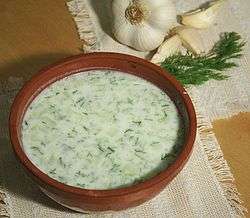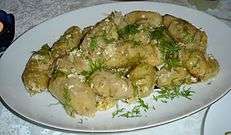Kosovan cuisine
Cuisine in Kosovo (Albanian: Kuzhina kosovare is similar to the cuisine of the surrounding places (Montenegro, southern Serbia, Albania, Republic of Macedonia), and has been significantly influenced by Turkish cuisine and Albanian cuisine, specifically Balkan cuisine. Common dishes include burek, pies, flija, kebab, suxhuk and other sausages, stuffed peppers, lamb, beans, sarma, burjan, pita and rice.[1] However, the cuisine varies slightly between different regions.
Bread and dairy are important staples in Kosovar Albanian cuisine. The most widely used dairy products are milk, yogurt, ayran, spreads, cheese and kaymak. Meat (beef, chicken and lamb), beans, rice and peppers are, likewise, major parts of the Kosovo Albanian diet. Vegetables are used seasonally. Usually, cucumbers, tomatoes and cabbage are pickled. Herbs such as salt, black pepper, red pepper and Vegeta are also popular.[2]
Kosovo Albanian cuisine has similarity with the Balkan cuisine, influenced by Albanian, Croatian, Serbian and Greek cuisine, especially a notable influence from the Turkish cuisine. Most of the cuisine consists homemade traditional food. Homemade it is not only Kosovo's favorite dish but is significantly the healthiest and freshest way to eat.
Kosovo albaniancuisine is not the same throughout the year. Its cuisine adjusts with the climate and the seasons and different regions in Kosovo have different dishes.The most common dishes like burek, pies, flija, kebab, suxhuk, sausages, stuffed peppers, lamb, beans, sarma, rice dishes and much more are used in the daily cuisine.Dairy products are always present in the daily dishes. The most common ones are milk, yogurt, ayran, spreads, cheese and kaymak. Kosovo's cuisine basic elements that are used to cook traditional food are: Meat, vegetables, herbs(mostly Mediterranean herbs).With the diversity of pies and meat, the Kosovo daily cuisine goes well with hot summers and cold winters.As a result of its continental climate the fresh vegetables are consumed in summer.The most common dishes during the winter time in Kosovo are made out of vegetable pickles and ajvar (hot or mild red peppers). These two dishes are usually done in the late summer days and are being consumed mostly in winter.
Preparation
Homemade food is still preferred by Kosovar people. Although the new western influence pushes the new generation to eat out, Kosovars usually prefer to eat at home.
Key ingredients
The key ingredient in most pastries is shorbet, which is used as a topping. Shorbet consists of water boiled with sugar. Other ingredients used in most meat dishes are, peppers, tomatoes, garlic, onion, red pepper, black pepper, and salt.
Breakfast
Breakfast in Kosovo is simple, usually consisting of bread and cheese, ajvar or scrambled eggs, with milk. French toast is also eaten by people in Kosovo.
Dairy products
Dairy products play a big role on the Kosovan diet, Šar cheese, cottage cheese, cow milk, goat milk, goat cheese, are widely used and part of the Kosovo daily diet. The dairy products are all locally produced, and you can get some at local Farmers Markets.
Bread
The pita is one of the most popular traditional breads, especially during Ramadan. It is usually used for breakfast and, in some cities, you can find somun baked with eggs and sujuk on top. Also, corn bread is very popular in Kosovo; it is called leqenik and it is often filled with spinach, or cheese. Although, it is eaten without any filling as well.[3]
Pies
Pies in Kosovo are known as "trejte",[4] or "pite". A variety of pies are common in Kosovo.

- Kullpite- pie with nothing inside and is covered with yogurt
- Burek- also known as pie in Albania. Byrek is made of pastry layers filled with meat, white cheese, spinach.
- Bakllasarm - a salty pie with yoghurt and garlic covering[5]
- Pumpkin pie
- Spinach pie
- Flija- a traditional food of Albania
- Leqenik, known also as Kryelanë (Krelanë) [6] [7]
- Resenik - cabbage pie [8]
- Purrenik - leek pie [9]
- Hithenik - nettle pie [10]
Salads

Most of the Salads are made quickly and simply. Typical salads ingredients include tomatoes, onion, garlic, pepper, cucumber, potato, cabbage, lettuce, carrots, and beans.
- Potato salad
- Tarator - a traditional salad made with cucumbers, garlic and yogurt. Very popular dish for summer.
- Tomato and cucumber salad
- Dried nettle salad
- Bean salad
- Shope salad - a simple salad made of tomato, cucumber, onions and white cheese.
Main dishes


Tavë prizreni a traditional casserole of Ottoman legacy. It is cooked with lamb, eggplants, green peppers, onions, tomatoes and served hot. Sujuk which consists of ground meat, usually beef, but in some non-Muslim parts of Kosovo, it is also made with pork. Pleskavica, çofte, Sarma is a dish used for lunch, very frequently, it consists of meat wrapped with cabbage or vine leaves.[11]
- Stuffed peppers - with meat, rice and vegetables
- Sujuk - traditional sausage across Balkan region
- Tave Gore[12] - a traditional dish with lamb meat
- Tavë kosi - baked lamb meat with yogurt
- Burian with eggs - traditional vegetable food with rice, spinach and eggs[13]
- Kebab
Fish
The most used fish dishes constitute of fried freshwater fish, like Zander and Carp. A speciality is considered the tavë krapi, carp cooked in a pot, more widely used in cities around the Dukagjini valley, notably Gjakova because of its relation with Shkodër. The garnish is composed of garlic, bay leaf, tomato, parsley. The head of the carp is usually served to the main guest.[14]
Desserts

Traditional Kosovan desserts are often made with sherbet, which is cooked sugar with either lemon or vanilla flavor. Baklava is one of the most widely used pastries in Kosovo. Another is Kajmaçin, which is composed of baked eggs, mixed with sugar and oil. Sheqer Pare is a pastry similar to Baklava, as it is topped with Sherbet. Other pastries such as Kaqamak, Tespishte, Rovani, Tulluma and Pallaqinka are also a very popular breakfast foods in Kosovo. They are usually topped with Nutella, Cheese, or Honey. Shampite or Llokuma is served as a treat for children, and mostly as the first treat to guests on the days of Bayram.[15]
- Baklava is a rich, sweet pastry made of layers of filo pastry filled with chopped nuts and sweetened with syrup or honey.[16]
- Sultjash is a dish made from rice mixed with water or milk and sometimes other ingredients such as cinnamon and raisins. Different variants are used for either desserts or dinners. When used as a dessert, it is commonly combined with a sweetener such as sugar.[17]
- Kadaif. This classic Albanian dessert of shredded phyllo dough is dusted with vanilla sugar and walnuts and baked until golden brown.[18]
- Hashyre
- Tespishte
- Kek
- Tullumba
- Havell
- Sheqerpare
Drinks


The most popular traditional drink in Kosovo is rasoj. One popular drink in Kosovo is boza, a malt drink made from maize and wheat. Another is grape rakija, the most widespread variety of rakija in Kosovo. Kompot, a drink made from pieces of fruits boiled with sugars, is served during the start of autumn when seasonal fruits such as apples and quince are ripe.
- Rasoj[19] - Cabbage Winter Drink
- Rakia - Rakia is an alcohol drink that is made of different kind of domestic and wild fruits, but the main fruit that is used in Kosovo for making rakia is grape.
- Boza - A sweet drink made maize(corn) and wheat flour, it's a refreshing summer drink.
- Ajron - A mix of yogurt, water and salt.
- Beer - Kosovo's local beers are "Birra Peja", "Birra Ereniku", "Birra Prishtina".
- Turkish coffee
- Mountain tea
| Part of a series on |
| Kosovo Albanians |
|---|
| Kosovo culture |
|
Art · Cinema · Dress · Literature · Music Sport · Cuisine · Mythology |
| By region or country |
|
Kosovo · Australia · Bulgaria Croatia · Germany Greece · Italy Kosovo · Macedonia Montenegro · Romania Serbia · Sweden Switzerland · Ukraine · United States |
| Varieties of Albanian |
|
Gheg · Tosk · Arvanitika Arbëresh · Cham |
| Religion |
|
Islam in Kosovo Christianity in Kosovo Roman Catholicism Kosovo Protestant Evangelical Church |
| History |
| Origins · History |
References
- ↑ Ukelli, Fikrije. 1001 Receta për çdo familje.
- ↑ http://www.podravka.com/company/markets/kosovo/tab-cuisine-of-kosovo
- ↑ http://ngiju.blogspot.com/2009/06/leqenik-i-misrit.html
- ↑ https://web.facebook.com/traditashqiptareofficial/posts/508809859249359?_rdr
- ↑ http://www.kosovoguide.com/?cid=2,227,1011
- ↑ http://www.femra.net/leqenik-i-shijshem-i-bute-dhe-i-thjeshte/
- ↑ http://recetatecekes.com/kryelane-misri-me-hithra/
- ↑ http://www.kuzhinashqiptare.com/receta/rasenik-pite-me-laker-te-bardhe/
- ↑ http://telegrafi.com/byrek-me-purri-e-qumesht/
- ↑ http://www.kuzhinashqiptare.com/receta/hithenik/
- ↑ http://www.kosovoguide.com/?cid=2,227
- ↑ http://www.scribd.com/doc/11058582/1000-receta-per-cdo-familje-
- ↑ http://www.artigatimit.com/2013/10/burani-me-spinaq-e-veze/
- ↑ "Tavë Krapi Shkodrane".
- ↑ http://rebibneenun.blogdetik.com/embelsira-kosovare/
- ↑ Bakllava
- ↑ Rice pudding
- ↑ http://www.marthastewart.com/852079/kadaif
- ↑ http://www.instructables.com/id/Cabbage-Winter-Drink-rasoj/
External links
Graham, Adam (20 August 2015). "In Kosovo, a Thirst for Progress, and Beer, Too". New York Times.